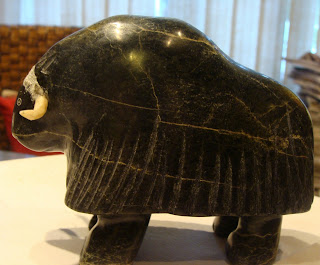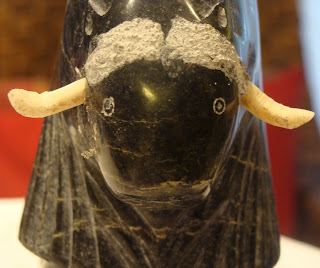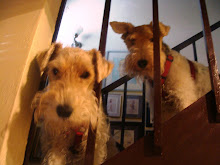
Whenever our mom goes on one of her "business trips," we both know she'll be bringing lots of stuff home with her. Sometimes it's treats for us. Sometimes new collars. Sometimes a stuffie or two. But most often it's something that goes on a wall (except we're pretty much out of wall space). Or something that goes on a shelf or a table (except we're pretty much out of empty flat surfaces too.). Or it's something that goes into a book case (30 pounds came back from Vancouver... and there's not much space to spare in the book cases either).
So we were kind of holding our breath when she came back from Nova Scotia. A few books, check. A calendar, check. A few prints, check. But nothing prepared us for this:


What is it you're probably wondering ?
According to mom, it's a musk ox sculpted by an Inuit artist. Just what we needed, eh?

According to Inuit.net http://www.inuitarteskimoart.com/m-About-inuitarteskimoart.php, the musk ox plays an important role in the Inuit's lives and the musk ox is a favourite subject, especially among male carvers who are also hunters..
Muskoxen *
Should you be lucky enough to see the trademark shaggy coat of the muskox (umingmak), you may feel like you've been transported back in time. Indeed, it's easy to imagine continental ice sheets covering much of North America — as they did some 18,000 years ago — when in the company of the "bearded one."
Should you be lucky enough to see the trademark shaggy coat of the muskox (umingmak), you may feel like you've been transported back in time. Indeed, it's easy to imagine continental ice sheets covering much of North America — as they did some 18,000 years ago — when in the company of the "bearded one."
Unlike the caribou, which prefer slow-growing lichens, muskoxen depend largely on grasses and sedges that recover relatively quickly from heavy grazing. In the summer, these herbivores may be seen in river valleys, along lake shores and near damp meadows. If grasses and sedges become unavailable in winter, muskoxen move onto ridges and hilltops to feed on willows and other plants. They are often seen in groups of 10 to 20, depending on season and location. When threatened, muskoxen form defensive circles with adults facing outwards and calves in the centre. This behavior, while effective against four-legged predators, makes muskoxen easy prey for human hunters.
Large numbers of muskoxen roamed the tundra of Nunavut before the arrival of European and Canadian traders. The subsequent market for meat and hides reduced their populations to dangerously low numbers until Canada protected them in 1917. Since then, muskoxen have recovered and recolonized most of their historic range so that closely regulated harvesting can be sustained. Today, Nunavut holds most of Canada's muskoxen, with about 60,000 animals. The species occupies much of Nunavut, except for the eastern mainland and Baffin Island.
Inuit do not usually prefer muskoxen over caribou, although the meat can be delicious and the skins produce warm sleeping robes. Beginning in May, muskoxen shed large quantities of their underfur (qiviut), which can be spun into a luxurious wool. Bulls weigh about 350 kilograms, some 50 kilograms heavier than cows. Muskoxen mate in the summer; bulls can become unpredictable during this period. Do not approach muskoxen too closely, especially if you're not accompanied by an experienced guide. They can be aggressive.
ABOUT THE WOOL²: The Oomingark [as the Inuit call it] is covered all over with "wool", except for it's horns,hooves, lips and nose, with an underlayer of short fine wool for exceptional warmth. Amuch longer outer coat composed of shaggy hair up to 24" in length covers theanimal, hanging nearly to the ground and giving the muskox its mystic appearance.
The coat is generally dark brown or nearly black. About the shoulders it is extremelyshaggy and forms a distinct mane, especially noticeable on bulls. Behind the shoulder is a short white or creamy yellow "saddle". The lower legs have light brown to white "stockings".
* - Reproduced from an article Land Mammals by Marian and Mike Fergusoncontained in the Nunavut Handbook
2 - Reproduced from NWT Wildlife Sketches Series - Muskox of tje Northwest Territories
This new guy, who apparently is to make himself at home somewhere up high where we can't reach him, is kind of heavy -- his dense little body weighs about two pounds. And -- this is for Gail and Bertie -- we think he's made of serpentine, one of the rock formations prevalent in parts of Canada. He does have a few Inuit cohorts here from previous forays -- but so far hasn't joined them.
We do seem to have one thing in common: musk oxen have double coats, just like we do. But is that enough to be BFFs?
So far, he hasn't a name -- although Mak, short for umingmak, the Inuit word for musk ox, is a starter. And he seems rather staid (no, Lacie, we're not sure if he dates or not). But we can't help but wonder: who needs this?
 When you have one of these???
When you have one of these???  And one of these???
And one of these???
Just askin'.
Jake and Just Harry

















17 comments:
Maybe woo should name him Roy ;-)
Hugz&Khysses,
Khyra
We think Mak is a great name. He is certainly an interesting piece - we hope to see more of him here:)
Did you try saying muskoxen fast fifteen or more times? BOL
Woos ~ Phantom, Thunder, and Ciara
Good question! And you know what? We've heard that musk oxen stink. NEVER have we been described that way.
Jake and Fergs
xxoo
Hey I sniffed you out, nice to meet yea, Look forward to meeting you on Berties field trip, looks like your moms been on her own field trip. Mak seams a good name to me
See Yea George xxx
What a great post-loved all the information-I love it and Mak sounds like as good a name as any!
Of course, nothing can hold a candle to you two good lookin' guys!
aw we thinks we like it loves and licks xxx
OK. He may have a double coat, but no way is he as good lookin' as you guys. Muzzer says he reminds her of a linebacker she dated in collidge. Dad says he is better looking than the linebacker
kisses
gussie
Hey
My thoughts exactly!! what good will that do, it just sits there. You tow provied enjoyment and happiness!!
wags
Jazzi
Hmmm... Mak sure is interesting and have a great story.
I hope you two get along well with him!
Kisses and hugs
Lorenza
Wow guys!
What an incredibly interesting and informative post! I was rivetted! Thank you for sharing all of the information surrounding your little treasure...most educational indeed!
The cultures and traditions of many ethnic peoples around the world are carved into their artifacts...yours is amazing!
We have a similar animal here in SA...the Cape Buffalo: similar in habit, but not short-haired and flat-coated, to allow for the temperatures of the African savannah...but I think they also protect their offspring like yours!
Thanks for a wonderful post!
Doggies....welcome him! He's gorgeous!
Sending lotsaluv
MAXMOM IN SA
He is kinda cute. We bet you'll be BFF in no time at all!
Love ya lots
Maggie and Mitch
Goodness , the look in that last but one photograph says it all.
Sometimes it is best not to think too long on what motivates the humans. One could have a mental sprain from doing that. I think your best plan is to act like that little beast is the best thing you have every seen and then remind the humans what adorable pups you are.
Slobbers,
Mango
well, of course, you two dudes are the bestest, but i think that mak guy is kinda cool! just give him a chance! ;)
*woof*
the booker man
I like your moms newest acquisition. We have a giant ceramic pig names Petunia and a giant ceramic frog named Herkima Jerkima that he would fit right in with
Kari
http://dogisgodinreverse.com/
Dog Dad enjoyed the muskox story and the fact it was serpentine. Dog Dad graduated from the school of hard rocks, because he has a masters in geology. BOL.
Essex & Deacon
Thank you very much for referencing our Gallery on your post. Unfortunatly the url you have posted is made incorrect by the comma at the end and does not click through as a result. Here is the corrct url - http://www.inuitarteskimoart.com/m-About-inuitarteskimoart.php
Thanks Again!
ABoriginArt Galleries
www.Inuit.net
Post a Comment